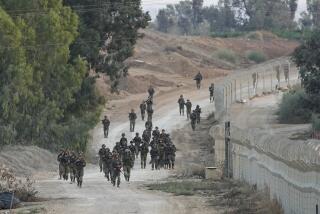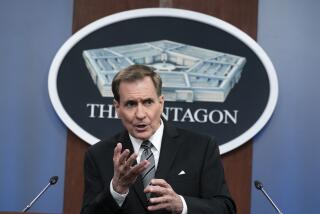U.S. Readiness for Iraqi Biological War Faulted : Military: Pentagon says troops early in Gulf War were poorly prepared for threatened use of such weapons.
- Share via
WASHINGTON — U.S. military forces were poorly prepared in the early days of the Persian Gulf War to counter Iraq’s threatened use of biological weapons, according to a new study released Tuesday by the Pentagon.
The study, a post-mortem focusing on “lessons learned” from the victorious six-week conflict with Iraq, also concluded that the United States must process intelligence data more quickly for battlefield commanders.
Other shortcomings, according to the study, occurred in communications among branches of the armed services and in clearing land and sea mines, especially those in shallow water.
Although the report generally praised the dedication, training and preparedness of more than 500,000 U.S. troops and reservists deployed to the Persian Gulf region, as well as their high-technology weaponry, it stressed that improvements in planning and logistics must be made in future operations to avoid heavier casualties imposed by a smarter, more experienced enemy.
“We will need to do better,” Defense Secretary Dick Cheney said in an introduction to the congressionally mandated report submitted to the Senate and House Armed Services committees.
Parts of the study paralleled the testimony on Capitol Hill last month by Gen. H. Norman Schwarzkopf, chief of U.S. Central Command forces in the Persian Gulf. Schwarzkopf testified that analyses by U.S. intelligence agencies of the damage wrought on Iraqi facilities and troops often were so watered down and qualified as to be of little practical use.
In addition, he said, the data was not relayed to senior officers on the ground in a timely, useful fashion.
Discussing Iraq’s threat to use biological and chemical weapons, the report said that when the first U.S. troops were deployed soon after the Aug. 2, 1990, invasion of Kuwait, the Pentagon “did not have a policy regarding vaccination against biological warfare agents.”
The report added that “vaccines were not available in significant quantities until early 1991.”
Intelligence assessments focused on the possibility that Iraqi President Saddam Hussein had weapons employing both anthrax and botulin toxins. But either germ weapon, used alone, “could have created enormous numbers of fatalities and could have overtaxed the medical treatment system,” the report said.
“A protective mask can filter out all BW (biological warfare) agents,” the study noted. “However, at the outset, there were no fielded systems to detect covert attacks, so there were no mechanisms to provide a warning until after medical symptoms appeared--too late to be of best value.”
The report added that more research is needed on protective clothing because “currently available chemical protective suits may not be optimal for wear in the desert during the summer months.”
Discussing intelligence-gathering problems, the study said that “although BDA (bomb damage assessment) at the outset of Operation Desert Storm was not adequate, improvement was noted as the war continued.” But it was necessarily “complicated by a number of factors, notably the number of targets struck and the large number of assessments made.”
The intelligence community “is examining ways to provide intelligence more quickly to the combat commander in the field,” the report said.
At the same time, better intelligence is needed to guarantee that U.S. and allied troops on the ground are not mistakenly fired upon by friendly aircraft, according to the report.
“We need an identification system that identifies friendly vehicles from the air at long ranges” in reduced visibility or darkness, the Pentagon said, adding that dozens of allied casualties resulted from “friendly fire.”
Turning to other operations, the report said U.S. forces “were not nearly good enough at clearing land and sea mines, especially shallow-water mines.” It declared that “this might have imposed significant additional costs had large-scale amphibious operations been required.”
Although high-technology systems, including cruise missiles and Stealth aircraft, proved “immensely effective” against Iraqi targets, the allied campaign to locate and destroy the enemy’s low-technology but highly mobile Scud missiles was “very difficult and diverted significant resources,” the report stated.
Cheney noted that the much-lauded Patriot missile defense system, deployed for the first time in the Gulf region, “worked, but imperfectly” in fending off Scud attacks.
The report said combat experience shows that the Patriot “required software modifications . . . to improve its anti-tactical ballistic missile capability.”
More to Read
Sign up for Essential California
The most important California stories and recommendations in your inbox every morning.
You may occasionally receive promotional content from the Los Angeles Times.













